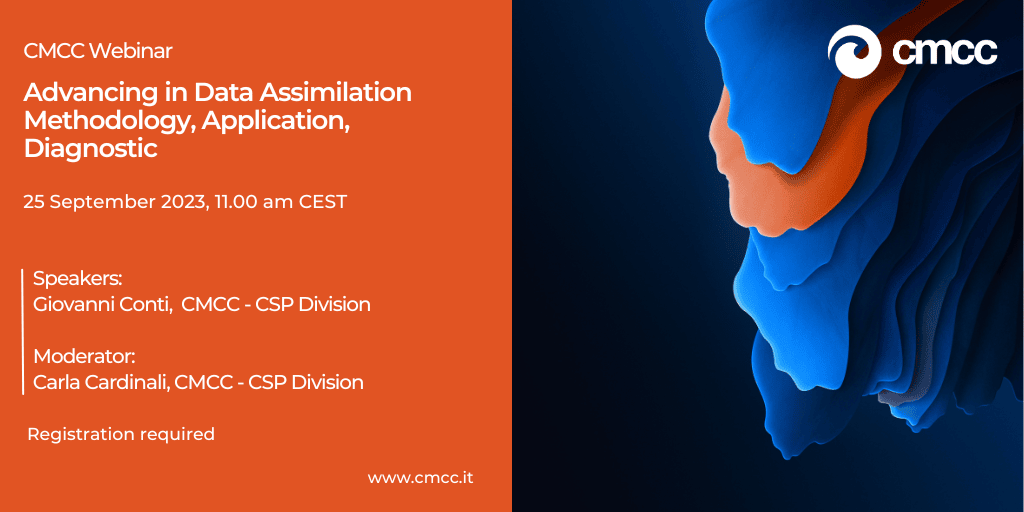CMCC Webinar
25 September 2023, 11.00 am CEST
To join the webinar, register here

Speaker
Giovanni Conti, CMCC – CSP Division
Moderator
Carla Cardinali, CMCC – CSP Division
Abstract
Novel ideas in the field of Data Assimilation (DA) are presented here. The ideas will cover various aspects of the DA field, starting from its mathematical formulation and the numerical representation (the application) selected to the construction of adaptive diagnostic tools that are verifying and measuring the quality and robustness of such a system.
First an extended deterministic physical nudging scheme will be introduced that incorporates two essential components: the background and observation information together with the assumed observation R and model error G co- variance matrix. These are the main components of classical data assimilation schemes. In particular, the first ideas presented here, proposes a data assimi- lation system that does not rely on the Bayesian framework. Instead, the data assimilation system is transformed into a boundary problem characterized by an initial and final condition. The relation between the Langevin and Fokker- Planck equations is leveraged to formulate the data assimilation problem in the probability space and extend the scheme in the coordinate space. The inclusion of background information arises from the recognition that the matrix G acts as a diffusion matrix in the Fokker-Planck equation, which is linked to the noise modulation in the corresponding Langevin equation. Instead, the observation error covariance matrix R, is taken into account by solving a Kolmogorov back- ward problem related to the boundary condition formulation. Notably, the final condition can be represented by a Gaussian function with a covariance matrix corresponding to R, the observation error covariance matrix. This dynamic treatment of the initial and final conditions simulates the DA problem.
Furthermore the Scalable and fully PaRallelised EArth Data-assimilation System, SPREADS, currently under development at CMCC is introduced. This system is based on an Ensemble Adjustment Kalman Filter initially devel- oped at NCAR, the open source Data Assimilation Research Testbed (DART). SPREADS has been highly developed to incorporate different and crucial as- pects of a data assimilation system: a spatial and temporal forward operator (similar to the FGAT formulation -First Guess at Appropriate Time). A flexible and dynamical query language database to handle the observations preprocess-ing and in memory. Finally, a fully modular representation of the main processes of the data assimilation problem and solution has been developed. The system can now support not only the assimilation of various observation types, from conventional ground-based to satellite measurements, but also millions of them.
Finally the last novel development presented here is an ad-hoc diagnostic tool, which enables to quantifies the leverage of each component of the assim- ilation system and their sub-optimalities. Understanding the contribution of observations to the analysis and forecast quality is crucial for model improve- ments and the design of the future global Earth system observation network. In recent years, advanced diagnostic tools have been developed and utilized to assess the value of the assimilated observations in terms of analysis and fore- cast quality. We will specifically discuss two measures: the Degree of Freedom for Signal (DFS) and the Forecast Sensitivity to Observation Impact (FSOI and FSOI-Jo). These measures have been proven to effectively diagnose the sub-optimality of the assimilation systems, as well as the model and observa- tion deficiencies. In particular, a novel development of the FSOI-Jo tool is presented, tailored for the ensemble Kalman filter implemented in SPREADS. FSOI- Jo utilizes an observation-based objective function (Jo) to calculate the short-range forecast error, whilst its variation quantifies the contribution of each of these observations to reduce the error. Finally, the high correlation between the observation impact in the analysis (DFS) and the observation impact in the forecast (FSOI-Jo) is demonstrated.
WATCH THE VIDEO
HOW TO PARTICIPATE
25 September 2023, 11.00 pm CEST
To join the webinar, register here
ORGANIZED BY:
CMCC

